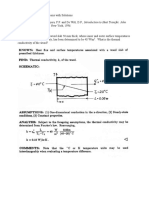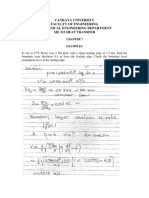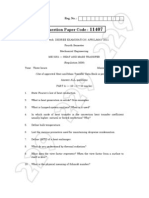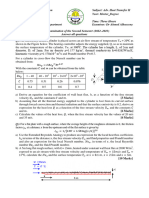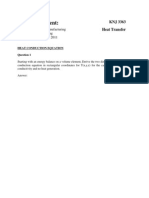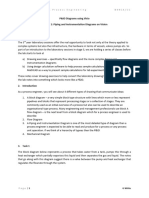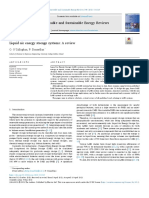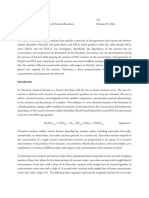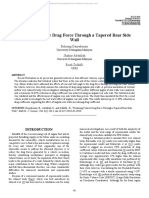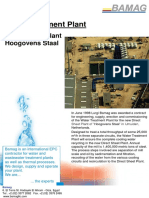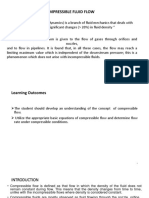Department of Mechanical Engineering
MCL242: Heat and Mass Transfer
Tutorial - 5
Introduction to Convective Heat and Mass Transfer
8th Sep – 26th Sep
1. In a particular application involving airflow over a heated surface, the boundary layer temperature
distribution may be approximated as
T − Ts u y
= 1 − exp − Pr
T − Ts
where, y is the distance normal to the surface and the Prandtl number, Pr = cp×μ/k = 0.7, is a
dimensionless fluid property. What is the surface heat flux if T∞ = 400 K, Ts = 300 K, and u∞/ν =
5000 m-1?
2. The heat transfer rate per unit width (normal to the page) from a longitudinal section, x2 - x1, can
be expressed as q12' = h12 ( x2 − x1 )(Ts − T ) , where h12 is the average heat transfer coefficient for
the section of length (x2 - x1). Consider laminar flow over a flat plate with a uniform temperature
Ts. The spatial variation of the local convection coefficient is of the form hx = Cx-1/2, where C is
a constant.
(a) Beginning with the convection rate equation in the form dq’ = hxdx(Ts - T∞), derive an
expression for h12 in terms of C, x1, and x2.
(b) Derive an expression for h12 in terms of x1, x2, and the average coefficients h1 and h2 ,
corresponding to lengths x1 and x2, respectively.
3. Consider airflow over a flat plate of length L = 1 m under conditions for which transition occurs
at xc = 0.5 m based on the critical Reynolds number, Rex,c = 5 × 105.
(a) Evaluating the thermophysical properties of air at 350 K, determine the air velocity.
(b) In the laminar and turbulent regions, the local convection coefficients are, respectively,
hlam ( x) = Clam x −0.5
hturb ( x) = Cturb x −0.2
where, at T = 350 K, Clam = 8.845 W/m3/2-K, Cturb = 49.75 W/m1.8-K, and x has units of m. Develop
an expression for the average convection coefficient, hlam ( x ) , as a function of distance from the
leading edge, x, for the laminar region, 0 ≤ x ≤ xc.
(c) Develop an expression for the average convection coefficient, hturb ( x ) , as a function of
distance from the leading edge, x, for the turbulent region, xc ≤ x ≤ L.
(d) On the same coordinates, plot the local and average convection coefficients, hx and h ( x) ,
respectively, as a function of x for 0 ≤ x ≤ L.
�4. Consider conditions for which a fluid with a free stream velocity of V = 1 m/s flows over a surface
with a characteristic length of L = 1 m, providing an average convection heat transfer coefficient
of h = 100 W/m2-K. Calculate the dimensionless parameters NuL, ReL, Pr, and jH for the
following fluids: air, engine oil, mercury, and water. Assume the fluids to be at 300 K.
5. Experimental measurements of the convection heat transfer coefficient for a square bar in cross
flow yielded the following values:
h1 = 50 W/m2 -K for V1 = 20 m/s
h2 = 50 W/m2 -K for V2 = 15 m/s
Assume that the functional form of Nusselt number is Nu = C Rem Pr n , where C, m, and n are
constants.
a) What will be the heat transfer coefficient for a similar bar with L = 1 m when V = 15 m/s/?
b) What will be the heat transfer coefficient for a similar bar with L = 1 m when V = 30 m/s/?
c) Will the results remain the same if the side of the bar is used as the characteristic length
insread of its diagonal?
6. Atmospheric air is in parallel flow (u∞ = 15 m/s, T∞ = 15°C) over a flat heater surface that is to
be maintained at a temperature of 140°C. The heater surface area is 0.25 m 2, and the airflow is
known to induce a drag force of 0.25 N on the heater. Determine the electrical power needed to
maintain the prescribed surface temperature.
7. A circuit board with a dense distribution of integrated circuits (ICs) and dimensions of 120 mm
by 120 mm on a side is cooled by the parallel flow of atmospheric air with a velocity of 2 m/s.
From wind tunnel tests under the same flow conditions, the average frictional shear stress on the
upper surface is determined to be 0.0625 N/m2. What is the allowable power dissipation from the
upper surface of the board if the average surface temperature of the ICs must not exceed the
ambient air temperature by more than 25°C? Evaluate the thermophysical properties of air at 300
K.
8. Photosynthesis, as it occurs in the leaves of a green plant, involves the transport of carbon dioxide
(CO2) from the atmosphere to the chloroplasts of the leaves, and the rate of photosynthesis may
be quantified in terms of the rate of CO2 assimilation by the chloroplasts. This assimilation is
� strongly influenced by CO2 transfer through the boundary layer that develops on the leaf surface.
Under conditions for which the density of CO2 is 6 × 10-4 kg/m3 in the air and 5 × 10-4 kg/m3 at
the leaf surface and the convection mass transfer coefficient is 10-2 m/s, what is the rate of
photosynthesis in terms of kilograms of CO2 assimilated per unit time and area of leaf surface?
9. On a cool day in April, a runner is known to lose heat at a rate of 500 W because of convection
to the surrounding air at T∞ = 10°C. The runner’s skin remains dry and at a temperature of Ts =
30°C. Three months later, the runner is moving at the same speed, but the day is warm and humid
with a temperature of T∞ = 30°C and a relative humidity of φ∞ = 60%. The runner is now
drenched in sweat and has a uniform surface temperature of 35°C. Under both conditions constant
air properties may be assumed with ν = 1.6 × 10-5 m2/s, k = 0.026 W/m-K, Pr = 0.70, and DAB
(water vapor–air) = 2.3 × 10-5 m2/s.
(a) What is the rate of water loss due to evaporation on a hot-humid day?
(b) What is the total convective heat loss on a hot-humid day?
10. In the spring, concrete surfaces such as sidewalks and driveways are sometimes very wet in the
morning, even when it has not rained during the night. Typical nighttime conditions are shown
below.
'' ''
(a) Determine the heat fluxes associated with convection, qconv , evaporation, qevap , and radiation
''
exchange with the sky, qrad .
(b) Do your calculations suggest why the concrete is wet instead of dry? Explain briefly.
(c) Is heat flowing from the liquid layer to the concrete? Or from the concrete to the liquid layer?
Determine the heat flux by conduction into or out of the concrete.
11. A homeowner has installed a circular hot tub in his backyard and finds that for the typical
operating conditions prescribed below, water must be added at a rate of 0.001 kg/s to maintain a
fixed water level in the tub. If the tub is well insulated on its sides and bottom and the temperature
of the makeup water is equal to that of the tub water, at what rate must electrical heaters supply
energy to maintain the tub water at 310 K?
�12. A disk of 20-mm diameter is covered with a water film. Under steady-state conditions, a heater
power of 200 mW is required to maintain the disk–water film at 305 K in dry air at 295 K and
the observed evaporation rate is 2.55 × 10-4 kg/h.
(a) Calculate the average convective mass transfer coefficient, hm , for the evaporation process.
(b) Calculate the average convective heat transfer coefficient, h .
(c) Do the values of hm and h satisfy the heat–mass analogy?
(d) If the relative humidity of the ambient air at 295 K were increased from 0 (dry) to 0.50, but
the power supplied to the heater was maintained at 200 mW, would the evaporation rate
increase or decrease? Would the disk temperature increase or decrease?

